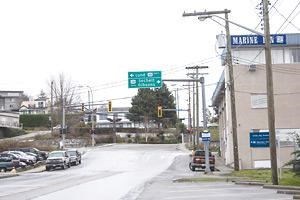Tourism Powell River is looking for signs of financial support from Powell River Regional District and the City of Powell River.
Paul Kamon, Tourism’s executive director, recently appeared before the regional district’s rural services committee. He requested financial contributions toward more than $100,000 the tourism organization wants to spend in its first phase of signage upgrading. He put a similar request to the city’s committee of the whole Thursday, December 18.
Kamon told the rural services committee that the signage report he had provided for the regional directors was one of the first tasks he took on when he joined Tourism Powell River three years ago. It started when he received a call to look at the ferry terminal sign at Little River.
“I went to investigate the sign and I pushed on it with my finger,” he said. “It went through the structure. When I came back I realized we had a bigger problem in that many of our signs that act as gateway information for our community are in disrepair. The information on many of the signs, including Earls Cove, is out of date and has essentially wrong information. This is what gives a first impression of our community and I think it’s wrong.”
During the past year and a half a grant was written and funds were received from Island Coastal Economic Trust (ICET) to create a comprehensive report and strategy for the project. Kamon said the process was lengthy and included a full inventory of all of the signage on the coast, excluding the backcountry. He said GPS coordinates were recorded, the signs were photographed and catalogued in Google Earth, as well as being featured in hardcopy documents.
Having completed the report, the tourism organization qualified to apply for infrastructure funding, Kamon said.
“The result of that was a decline, which was a bit of a mystery, considering they funded the first leg of our report,” he said. “The word I received in discussion with ICET was they don’t feel funding signage is their responsibility and that it is the responsibility of the community.”
Kamon said he was appearing before the rural services committee in the hope the regional district would consider funding the signage project to create a fresh new image for visitors.
Sandy McCormick, Electoral Area D director, said she thinks Kamon is right about the signs.
“It’s the front door and the first impression people get,” she said. “My question is about the dollar figures involved. The recommendation refers to transferring $100,000 from the Community Works Fund, yet on page two, you’re talking about a contribution of $50,000 from the regional district. What is it that you are talking about?”
Al Radke, the regional district’s chief administrative officer, said the original application was put into ICET and it would have required $50,000 to match with ICET’s contribution. Because ICET has fallen through, the request was for making up the difference.
Kamon said the cost of producing the signs deemed a priority is $126,500. Secondary sign priorities amount to an additional $107,500.
As well as also approaching the city, Kamon intends to approach School District 47.
“There are other components we are looking to bring on board,” he said. An alliance with the school district could include initiatives such as having signs constructed through its carpentry program so that students could receive credit for the manufacture, he explained.
Following Kamon’s presentation, the rural services committee recommended the regional board transfer $50,000 of Community Works Fund to Tourism Powell River on the condition that the city matches the funding and the regional board enters into an agreement with tourism on the intended use of the funds.



